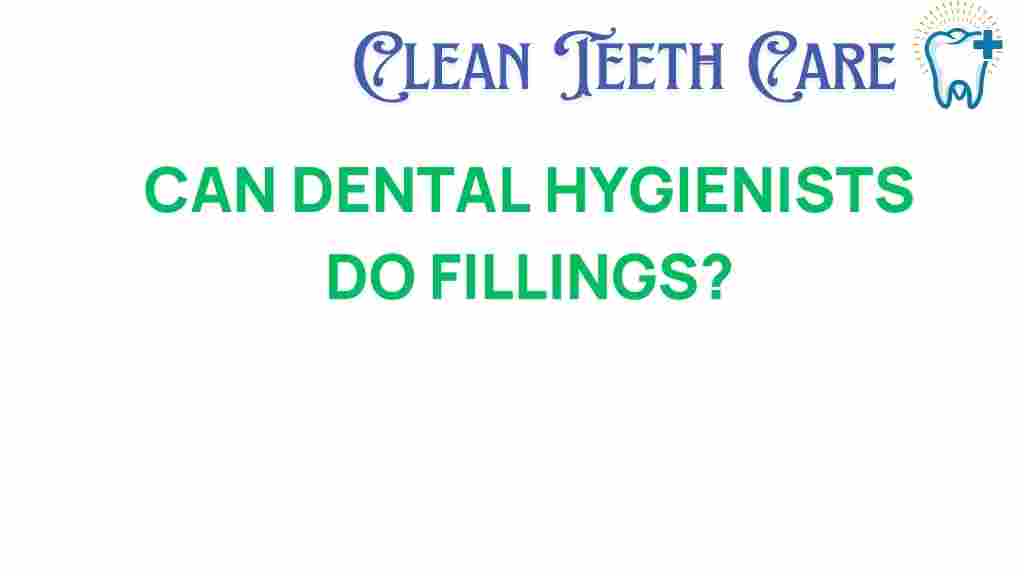Unveiling the Truth: Can Dental Hygienists Perform Fillings?
In the realm of dental care, the roles of various healthcare professionals are often misunderstood. One common question that arises is whether dental hygienists can perform fillings. This article aims to clarify the professional scope of dental hygienists, the procedures they can undertake, and the implications for overall oral health and patient safety.
Understanding the Role of Dental Hygienists
Dental hygienists are trained professionals specializing in preventive dentistry. Their primary role is to provide thorough cleanings, educate patients about oral hygiene, and assist in the prevention of dental diseases. However, their scope of practice can vary significantly depending on state regulations and the policies of individual dental practices.
Scope of Practice for Dental Hygienists
The professional scope of dental hygienists includes:
- Performing dental cleanings
- Applying sealants and fluoride treatments
- Taking dental X-rays
- Educating patients on oral health practices
- Conducting assessments and screenings for oral diseases
While dental hygienists play a crucial role in preventive care, the question remains: can they also perform fillings? The answer is nuanced.
Can Dental Hygienists Perform Fillings?
In most states, dental hygienists are not permitted to perform fillings independently. The placement of dental fillings is generally reserved for licensed dentists, who have undergone extensive training in operative dentistry. However, in some states, dental hygienists may have the ability to perform certain restorative procedures, including fillings, under the supervision of a dentist.
Factors Influencing the Ability of Hygienists to Perform Fillings
The ability of dental hygienists to perform fillings depends on several factors:
- State Regulations: Each state has its own laws and regulations governing the practice of dental hygienists. Some states allow hygienists to administer local anesthesia and perform restorative procedures, while others do not.
- Additional Training: Hygienists who wish to perform fillings may need to pursue additional training or certifications. This can include coursework, hands-on practice, and examinations.
- Supervision Requirements: In states where hygienists are allowed to perform fillings, they often must do so under the direct supervision of a licensed dentist. This ensures that patient safety remains a top priority.
Preventive Dentistry and Patient Safety
The primary focus of dental hygienists is preventive dentistry. By emphasizing preventive care, they help reduce the incidence of cavities and other oral health issues that would necessitate fillings. Here’s how hygienists contribute to oral health and patient safety:
- Education: Hygienists educate patients on the importance of regular dental check-ups, proper brushing and flossing techniques, and dietary choices that support oral health.
- Early Detection: Through routine cleanings and assessments, hygienists can identify early signs of decay and other issues, allowing for timely intervention by a dentist.
- Minimizing Anxiety: Many patients feel more comfortable with hygienists than with dentists, which can lead to improved compliance with preventive measures.
Step-by-Step Process: How Dental Hygienists Contribute to Filling Decisions
While dental hygienists may not directly perform fillings in most cases, they play a vital role in the overall process. Here’s a step-by-step overview:
- Initial Assessment: During a dental cleaning, the hygienist assesses the patient’s oral health, looking for signs of cavities or other issues.
- X-rays: If necessary, the hygienist may take X-rays to provide a clearer picture of the patient’s dental health.
- Consultation: After the assessment, the hygienist discusses findings with the dentist, who will make the final decision regarding fillings and other treatments.
- Treatment Planning: If fillings are required, the dentist will develop a treatment plan, which may involve the hygienist for certain preparatory tasks.
Troubleshooting: Common Concerns and Questions
Patients may have various concerns when it comes to understanding the roles of dental hygienists and the process surrounding fillings. Here are some common questions:
- Can I see a dental hygienist for a filling? Generally, no. Fillings are performed by dentists, but hygienists can help assess the need for fillings.
- How can I prevent the need for fillings? Maintain good oral hygiene, visit your dentist regularly, and consider sealants or fluoride treatments offered by hygienists.
- What if I have anxiety about dental procedures? Discuss your concerns with your hygienist or dentist; they can provide strategies to help you feel more comfortable.
The Importance of Collaboration Among Healthcare Professionals
Effective dental care involves collaboration among various healthcare professionals. Dentists, hygienists, and dental assistants all play unique but interconnected roles in ensuring optimal oral health. This teamwork enhances patient outcomes and promotes safety.
Conclusion
In summary, while dental hygienists are integral to the dental care process, the performance of fillings is typically outside their scope of practice. However, they play a critical role in preventive dentistry, patient education, and the early detection of dental issues. By working collaboratively with dentists and other healthcare professionals, dental hygienists contribute significantly to the overall well-being of patients.
For more information about the roles of dental hygienists and their contribution to oral health, visit this resource. To learn about the regulations in your state, check out this link.
This article is in the category Treatments and created by CleanTeethCare Team
